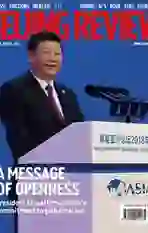Neighborly Conduct
2018-05-06ByChengXizhong
By Cheng Xizhong

Despite ups and downs, the Sino-Indian relationship has generally maintained a friendly and cooperative orientation in past decades. After experiencing a border stand off last year, the two countries bilateral relations are gaining momentum.
Low ebb
Last June, a border stand off erupted between the two sides when Indian military personnel entered Chinese territory in the Donglang area from Indias Sikkim State in the west, intervening in construction work by Chinese border forces. In the aftermath, regarding the incident as having harmed its territorial integrity and national security, China conducted firm negotiations while showing respect and restraint, which ultimately resulted in a peaceful solution without direct military confrontation.
Thereafter, there have been several further acts by India which have continued to harm the development of the two countrys bilateral relationship. On January 12 ahead of the Indian Army Day, General Bipin Rawat, Chief of Army Staff of the Indian Army, said at a press conference that “We felt they[China] will try to claim the whole Donglang… It was also posing a threat to us as it was changing the status quo.” He went on to say that “China is a powerful country but we are not a weak nation,” explaining that “the time had come for India to shift focus to its northern border.”
On February 15, the day before the Chinese Spring Festival, Indian Prime Minister Narendra Modi visited the so-called Arunachal Pradesh, an area of southern Tibet occupied by India. In the same month, General Rawat made another inflammatory statement, this time in New Delhi, claiming that a “planned” influx of people from Bangladesh into Indias northeastern region was underway as part of a proxy war being waged by Pakistan with support from China to destabilize the area.
There have also been reports about India joining the U.S.-led Indo-Pacific Strategy and playing a more active role in the informal strategic dialogue between the United States, Japan, Australia and India known as the Quadrilateral Security Dialogue. These events signal a recent low point in the SinoIndian relationship.
Positive diplomacy
Yet in spite of these recent troubles, China has insisted on pushing toward positive change. On December 11, 2017, Chinese Foreign Minister Wang Yi met Indian Minister of External Affairs Sushma Swaraj on the sidelines of the 15th Russian, Indian and Chinese Foreign MinistersMeeting in New Delhi. Eleven days later on December 22, then State Councilor Yang Jiechi attended the 20th round of talks between Chinese and Indian special representatives on boundary issues in the Indian capital. These two exchanges both helped to move the bilateral relationship onto a positive track.
